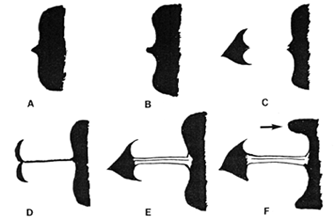


Go to chapter: 1 | 2 | 3 | 4 | 5 | 6 | 7 | 8 | 9 | 10 | 11 | 12 | 13 | 14 | 15 | 16 | 17 | 18 | 19 | 20 | 21 | 22 | 23 | 24 | 25 | 26 | 27 | 28 | 29 | 30 | 31 | 32 | 33 | 34 | 35 | 36 | 37 | 38 | 39
Chapter 23 (page 103)




Go to chapter: 1 | 2 | 3 | 4 | 5 | 6 | 7 | 8 | 9 | 10 | 11 | 12 | 13 | 14 | 15 | 16 | 17 | 18 | 19 | 20 | 21 | 22 | 23 | 24 | 25 | 26 | 27 | 28 | 29 | 30 | 31 | 32 | 33 | 34 | 35 | 36 | 37 | 38 | 39
Chapter 23 (page 103)
 |
Fig. 23.1 A-F. More common radiographic signs of infantile hypertrophic pyloric stenosis (after Astley, 1952). A Central "beak". B Beak with adjacent concave indentations (shoulder sign). C Beak, gap and cap. D String sign. E Longitudinal mucosal folds. F Concave indentation base of cap. Pyloric "tit" (arrow) |
Previous Page | Table of Contents | Next Page
© Copyright PLiG 1998